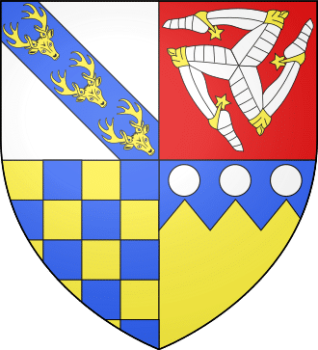The Stanley’s intentions in 1485: Croyland Chronicle’s Account
Thomas, Lord Stanley and his brother Sir William Stanley were courted by King Richard III and Henry Tudor in 1485. After Henry Tudor landed at Milford Haven there was increased concern from Richard and his followers that the Stanley’s may choose to side with the invader. This was because Lord Stanley had married Henry Tudor’s mother, Margaret Beaufort. The route taken by Henry was not directly into England as expected, instead he chose to head north before turning eastwards. This put the Tudor force on a route that would take them into lands dominated by the Stanley brothers. With their large and respected retinues, the loyalty of Lord Stanley and his brother was potentially crucial.
Lord Stanley’s Reputation
Thomas, Lord Stanley has a reputation for managing to avoid battle. It stems largely from his failure to answer Richard III’s summons due to a claim on being unwell. In simple terms he could try and sit out the campaign without bearing arms. This would prevent him being attainted or executed should he choose the losing side. However, Stanley’s son, Lord Strange, was unable to evade the King’s questioning. He informed the King that his uncle, Sir William Stanley, planned to join forces with Henry Tudor. He assured the King that his father had no such plans.
Lord Strange
Lord Strange was then held as a hostage by King Richard III. This was used as a means of coercing Thomas, Lord Stanley, into remaining on the side of Richard III. Should he join with the Tudor invader, his sons life would be forfeited.
Issues facing nobles
Knowing what did happen as the two sides faced each other in battle at Bosworth perhaps makes it hard to grasp the uncertainties that either commander faced. Nobles had a lot to gain, or lose, through their choices in warfare. The previous three decades had seen numerous nobles killed in battle, summarily executed, forced into lengthy exile, attainted, or snubbed as a result of being on the wrong side at a battle.
The Stanley’s: A Wanted Family
The Stanley family in 1485 found themselves as being possibly the most sought after of the baronial families. As soon as the invasion force was heading through North Wales it was they who could help or hinder the progress of Tudor the most.

The Stanley Brother’s and Henry Tudor
The Croyland Chronicle recounts the events relating to the Stanley families decisions in the build up to the Battle of Bosworth.
The king’s opponents, as already stated, having landed at Milford in Wales, made their way through rugged and indirect tracts in the northern part of that province ; where William Stanley, the brother of the said lord seneschal, as lord chamberlain of North Wales, was holding the sole command. Upon this, the king sent word to the said lord Stanley, requesting him, without the least delay, to present himself before him at Nottingham. For the king was afraid lest that, as it really turned out, the mother of the said earl of Richmond, whom the lord [Thomas] Stanley had married, might induce her husband to go over to the party of her son. On this, with wonder he made an excuse that he was suffering from an attack of the sweating sickness, and could not possibly come. His son, however, who had secretly prepared to desert from the king, was detected by stratagem and taken prisoner; upon which, he discovered a conspiracy which had been entered into by himself and his uncle, Sir William Stanley before-mentioned, and Sir John Savage, to go over to the side of the earl of Richmond; while at the same time, he implored the king’s mercy, and promised that his father would with all speed arrive to the king’s assistance. In addition to this, he sent word to his father by letter, of the danger to which he was exposed, and, at the same time, expressed his own wish that he would give the assistance beforementioned.
In the meantime the said two knights being publicly proclaimed at Coventry and elsewhere traitors against the king, and the enemy hastening on and directing his steps night and day to meet the king, it became necessary to move the army, though its numbers were not yet fully made up, from Nottingham, and to come to Leicester.
Image Credits
Coats of Arms are Public Doman sourced from Wikimedia.
Battlefield image: Lord Stanley in the Act of placing the Crown of Richard III on the Earl of Richmond in Bosworth Field.
Noblemen in armour gathered under a makeshift tent, a cloth hung between tree branches, raising their swords, as Lord Stanley places a crown on the head of Henry Tudor, gesturing towards him and looking towards the viewer, while Henry looks to left towards the victorious army, which acclaims him King; scratched open-letter state. 1790. Francis Chesham. Etching and engraving. British Museum image released under a Creative Commons Attribution-NonCommercial-ShareAlike 4.0 International (CC BY-NC-SA 4.0) license


